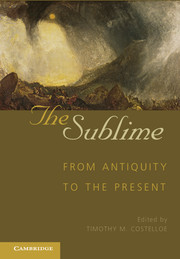Book contents
- Frontmatter
- Contents
- List of Illustrations
- Contributors
- Acknowledgments
- The Sublime
- Part One Philosophical History of the Sublime
- Part Two Disciplinary and other Perspectives
- 10 The First American Sublime
- 11 The Environmental Sublime
- 12 Religion and the Sublime
- 13 The British Romantic Sublime
- 14 The Sublime and the Fine Arts
- 15 Architecture and the Sublime
- Bibliography
- Index
- References
15 - Architecture and the Sublime
Published online by Cambridge University Press: 05 January 2015
- Frontmatter
- Contents
- List of Illustrations
- Contributors
- Acknowledgments
- The Sublime
- Part One Philosophical History of the Sublime
- Part Two Disciplinary and other Perspectives
- 10 The First American Sublime
- 11 The Environmental Sublime
- 12 Religion and the Sublime
- 13 The British Romantic Sublime
- 14 The Sublime and the Fine Arts
- 15 Architecture and the Sublime
- Bibliography
- Index
- References
Summary
When Immanuel Kant observed in the Critique of the Power of Judgment (1790) that the view of the starry heavens provoked the sentiment of the sublime, he was gazing into the epicenter of the potential relationship of architecture to the sublime. Indeed, several years before, in 1784, the French architect Étienne-Louis Boullée had sought to honor Sir Isaac Newton for having discovered the single principle that regulated the workings of the universe – gravity – by burying him, or more properly speaking, his manes (spirit) “within his discovery,” that is, within an architectural rendition of the cosmos (Figure 15.1). Boullée wanted to place Newton’s sarcophagus at the bottom of a vast spherical cavity whose dome was to have been punctured with small holes so as to allow the sun to shine through in the guise of twinkling stars, such that the viewer would experience an artificial rendition of the most quintessential of sublime scenes in the presence of Newton’s manes.
Both Kant’s observation and Boullée’s project anticipate Charles Blanc’s later insight that would relate the sublime to infinity and the absolute: “Issuing from the depths of nature, emanating from the divine, the sublime is absolute, imperishable…. The sublime is like a sudden glimpse of infinity.” Blanc, in turn, was paraphrasing Longinus, who, in similar words, conveys another aspect of the sublime: the immediate and intense feeling that it produces or that characterizes it. The sublime, he writes, is a feeling in response to some stimulus: “That … is grand and lofty, which the more we consider, the greater Ideas we conceive of it; whose Force we cannot possibly withstand; which immediately sinks deep, and makes such Impressions on the Mind as cannot be easily worn out or effaced.” In the Critique of the Power of Judgment (1790), Kant repeatedly emphasizes that the sublime involves a feeling rather than an idea and that it resides not in the object but in a “disposition of the mind” (CJ 5:265).
Information
- Type
- Chapter
- Information
- The SublimeFrom Antiquity to the Present, pp. 230 - 274Publisher: Cambridge University PressPrint publication year: 2012
References
Accessibility standard: Unknown
Why this information is here
This section outlines the accessibility features of this content - including support for screen readers, full keyboard navigation and high-contrast display options. This may not be relevant for you.Accessibility Information
- 2
- Cited by
